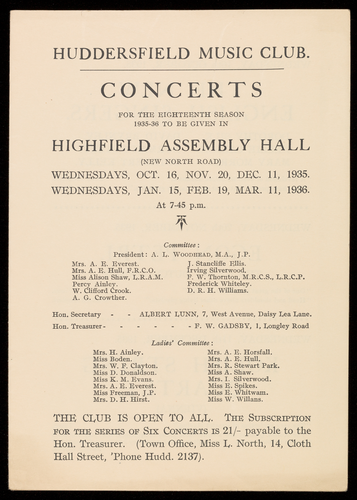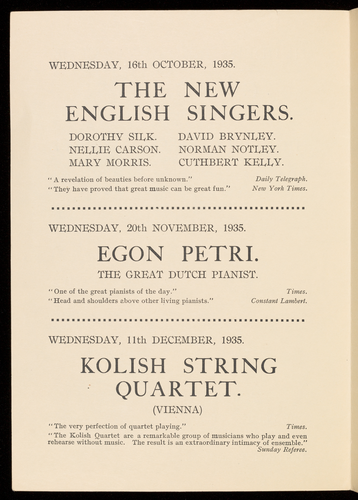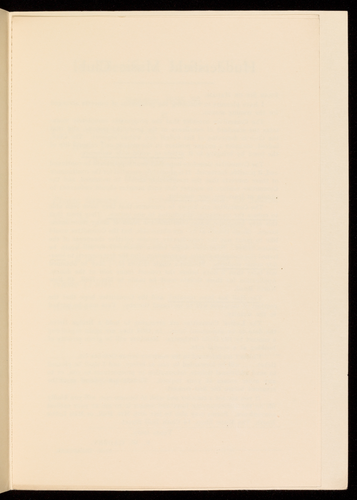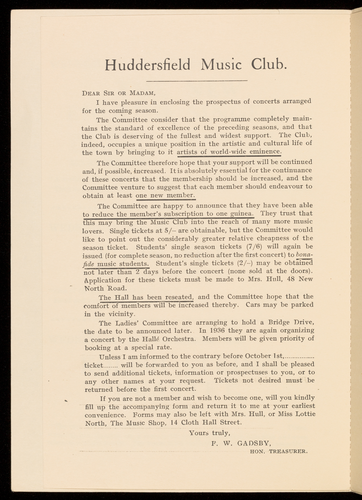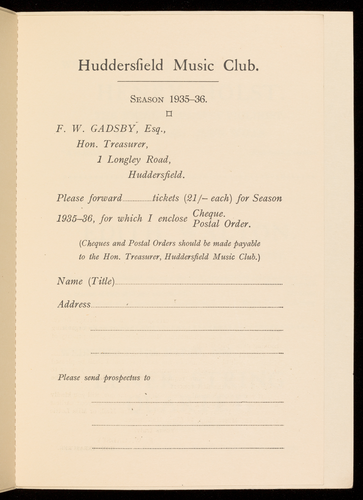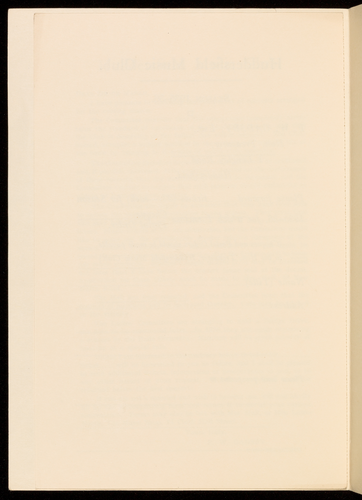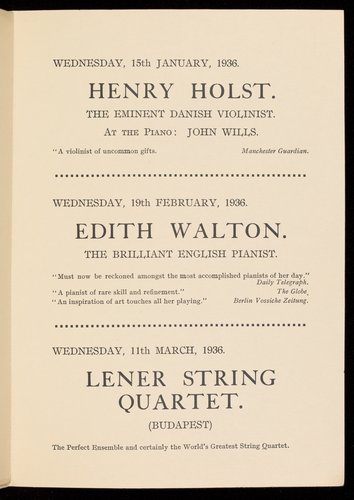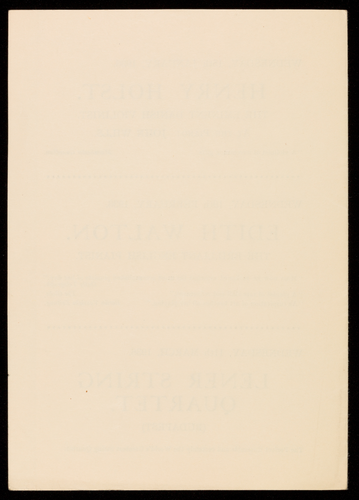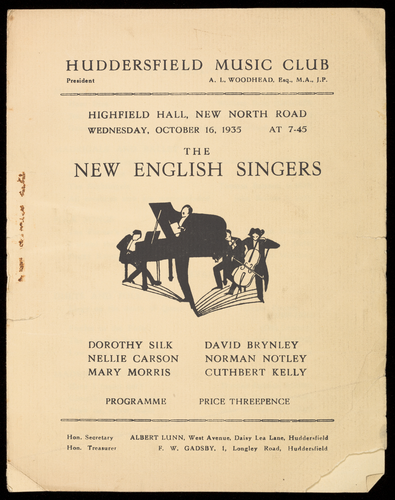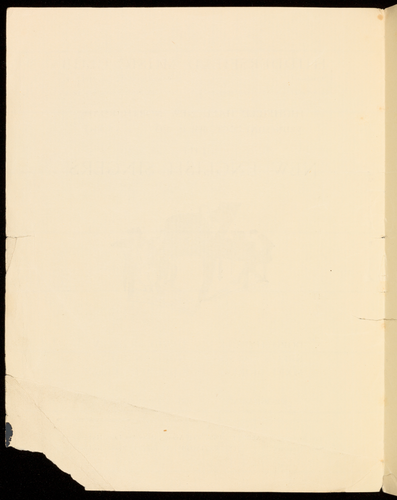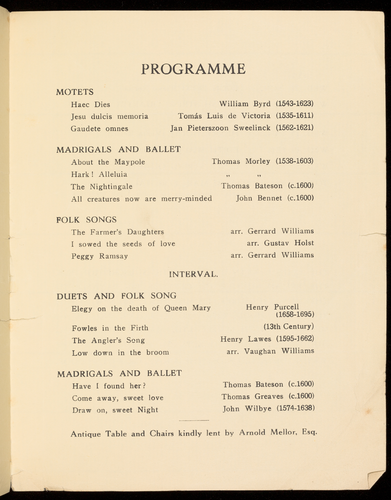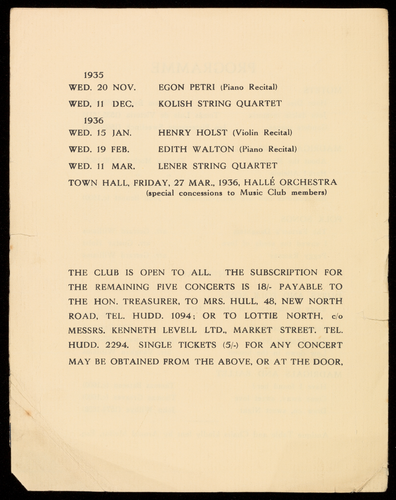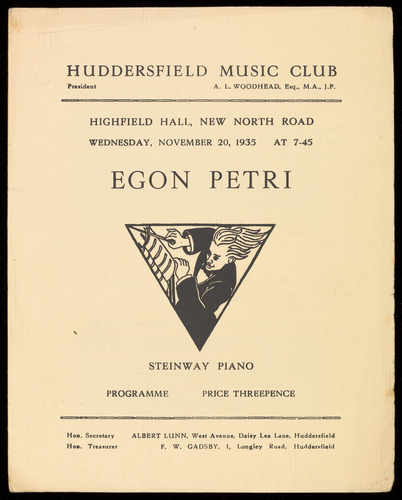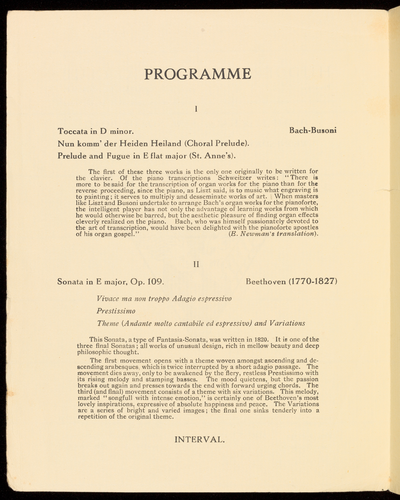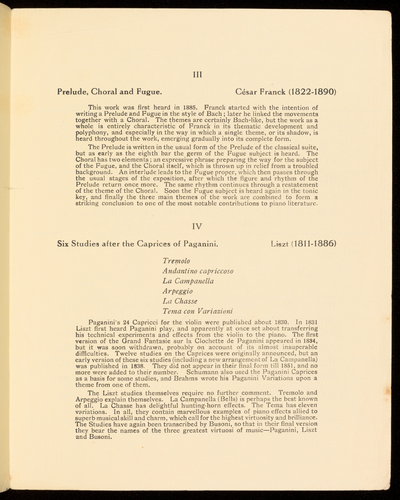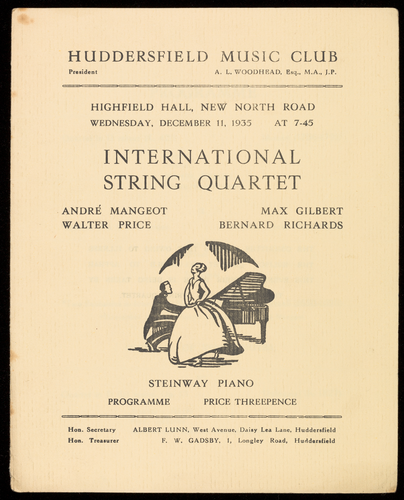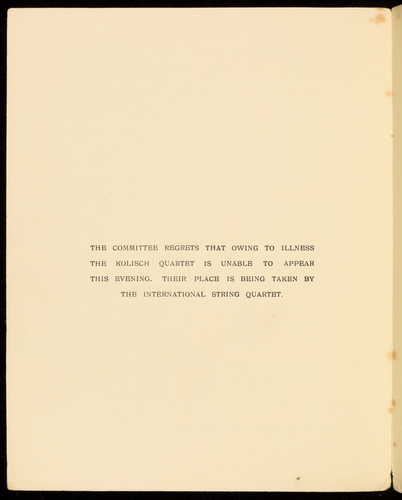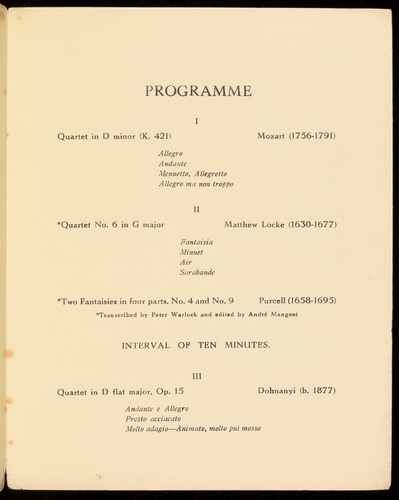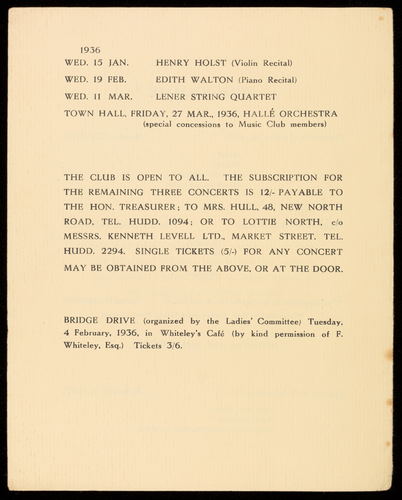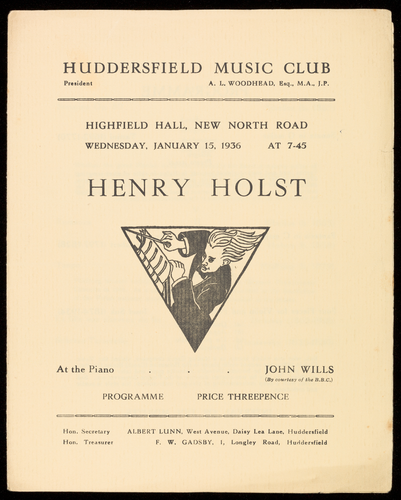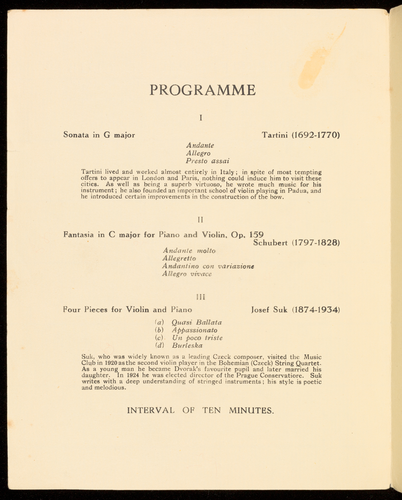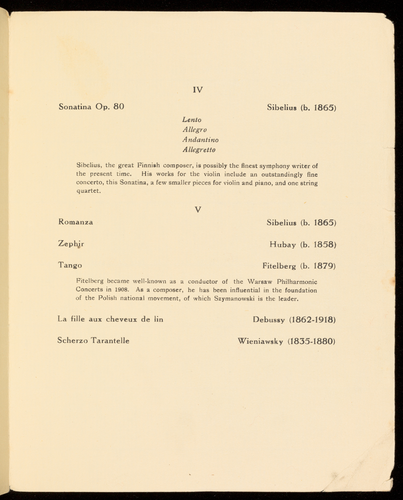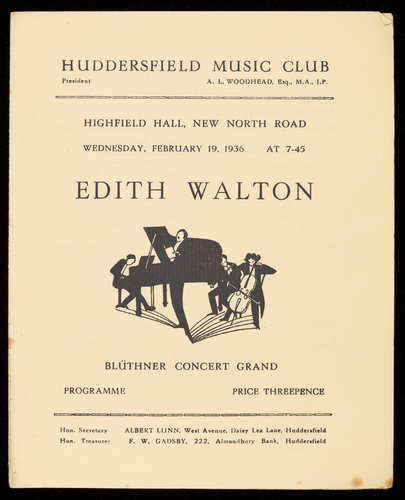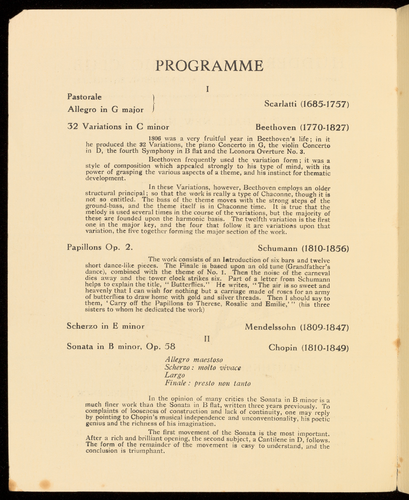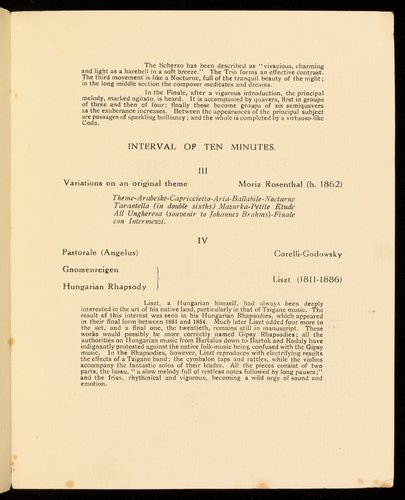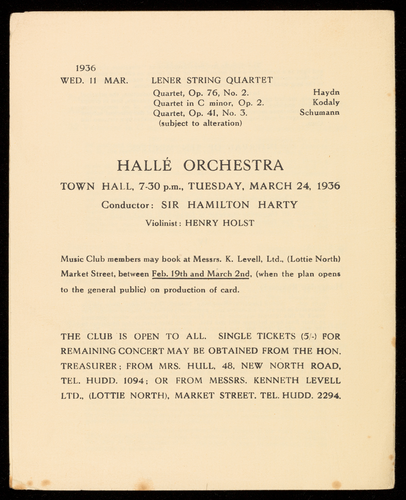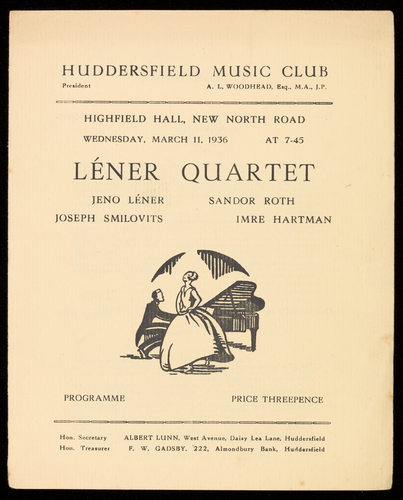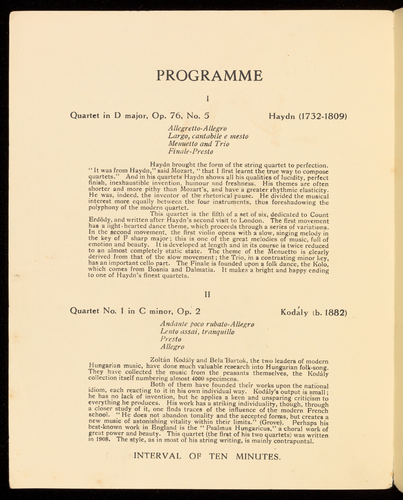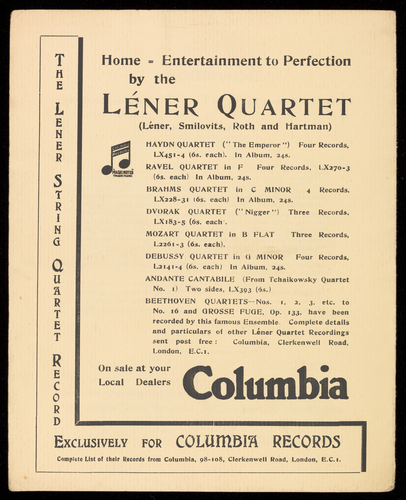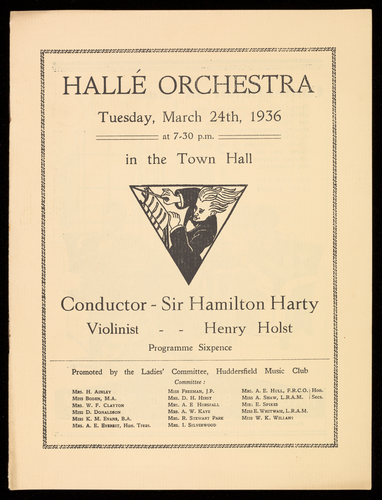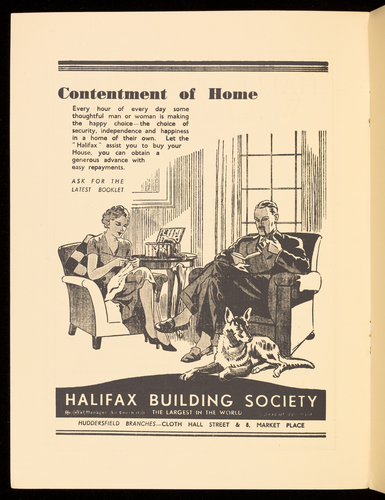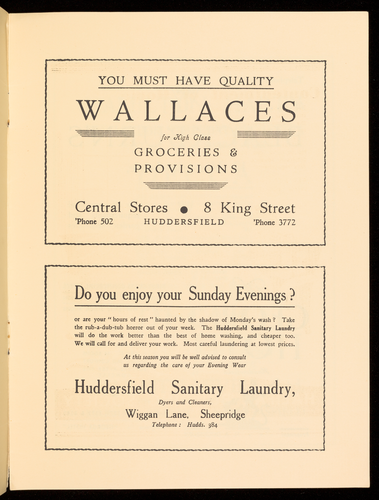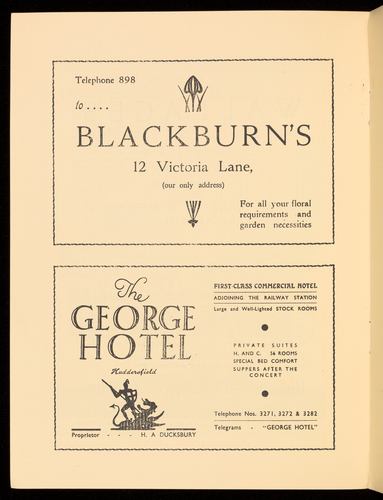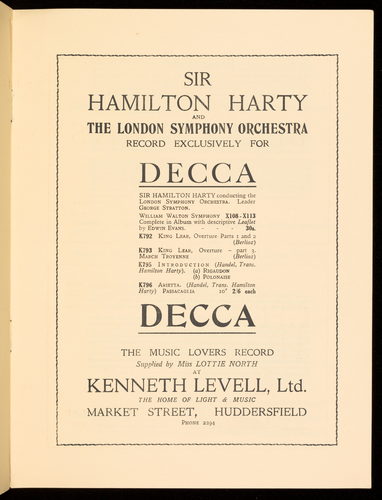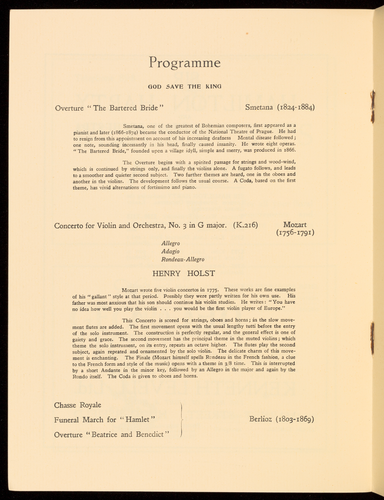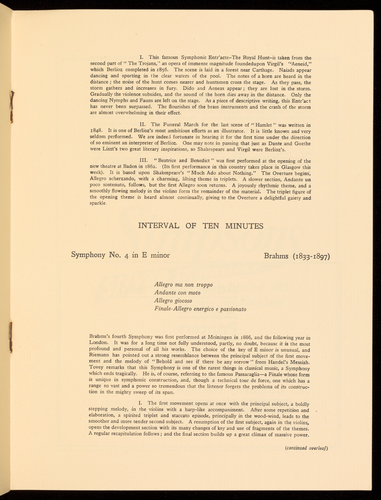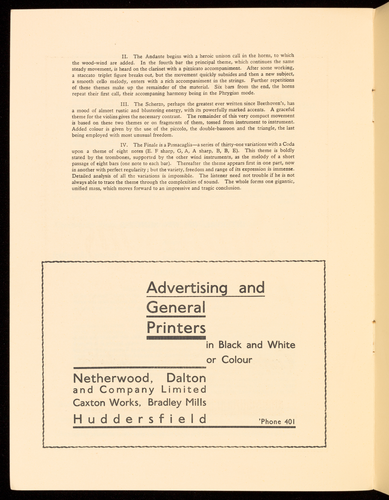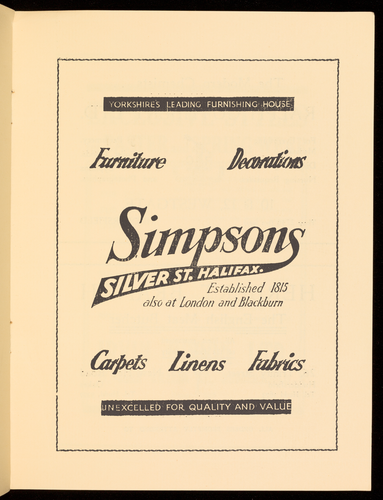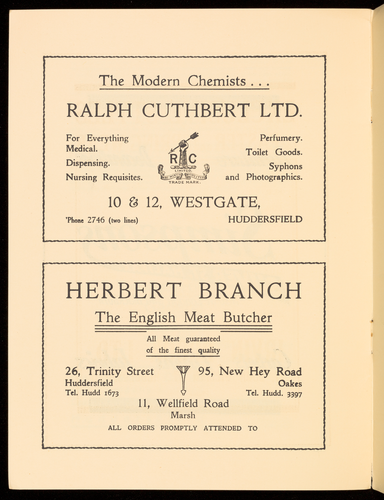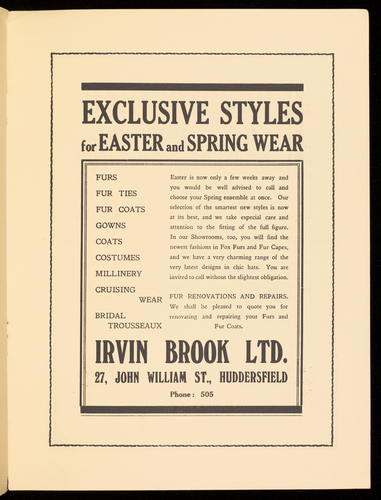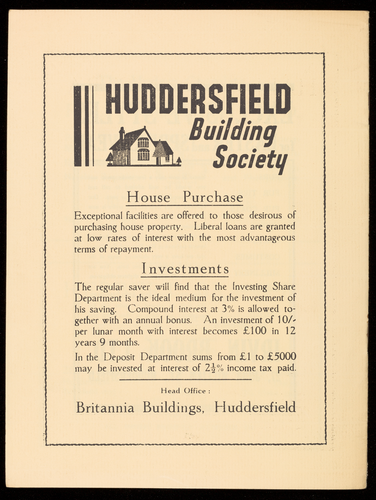Ocr'd Text:
HUDDERSFIELD MUSIC CLUB.
CONCERTS
FOR THE EIGHTEENTH SEASON
1935-36 TO BE GIVEN IN
HIGHFIELD ASSEMBLY HALL
(NEW NORTH ROAD)
WEDNESDAYS, OCT. 16, NOV. 20, DEC. 11, 1935.
WEDNESDAYS, JAN. 15, FEB. 19, MAR. 11, 1936.
At 7-45 p.m.
R
Mrs. A. E. Everest.
Mrs. A. E. Hull, F.R.C.O.
Miss Alison Shaw, L.R.A.M.
Percy Ainley.
W. Clifford Crook.
A. G. Crowther.
Hon. Secretary
Hon. Treasurer -
President: A. L. WOODHEAD, M.A., J.P.
J. Stancliffe Ellis.
Irving Silverwood.
F. W. Thornton, M.R.C.S., L.R.C.P.
Frederick Whiteley.
D. R. H. Williams.
6
Committee:
ALBERT LUNN, 7, West Avenue, Daisy Lea Lane.
- F. W. GADSBY, 1, Longley Road
Mrs. H. Ainley.
Miss Boden.
Mrs. W. F. Clayton.
Miss D. Donaldson.
Miss K. M. Evans.
Mrs. A. E. Everest.
Miss Freeman, J.P.
Mrs. D. H. Hirst.
8
Ladies' Committee:
Mrs. A. E. Horsfall.
Mrs. A. E. Hull.
Mrs. R. Stewart Park.
Miss A. Shaw.
Mrs. I. Silverwood.
Miss E. Spikes.
Miss E. Whitwam.
Miss W. Willans.
THE CLUB IS OPEN TO ALL. THE SUBSCRIPTION
FOR THE SERIES OF SIX CONCERTS IS 21/- payable to the
Hon. Treasurer. (Town Office, Miss L. North, 14, Cloth
Hall Street, 'Phone Hudd. 2137).
Ocr'd Text:
WEDNESDAY, 16th OCTOBER, 1935.
THE NEW
ENGLISH SINGERS.
DAVID BRYNLEY.
NORMAN NOTLEY.
CUTHBERT KELLY.
DOROTHY SILK.
NELLIE CARSON.
MARY MORRIS.
"A revelation of beauties before unknown."
"They have proved that great music can be great fun."
WEDNESDAY, 20th NOVEMBER, 1935.
EGON PETRI.
THE GREAT DUTCH PIANIST.
"One of the great pianists of the day."
Head and shoulders above other living pianists."
WEDNESDAY, 11th DECEMBER, 1935.
Daily Telegraph.
New York Times.
QUARTET.
(VIENNA)
Times.
Constant Lambert.
KOLISH STRING
"The very perfection of quartet playing."
Times.
"The Kolish Quartet are a remarkable group of musicians who play and even
rehearse without music. The result is an extraordinary intimacy of ensemble."
Sunday Referee.
Ocr'd Text:
Huddersfield Music Club.
DEAR SIR OR MADAM,
I have pleasure in enclosing the prospectus of concerts arranged
for the coming season.
The Committee consider that the programme completely main-
tains the standard of excellence of the preceding seasons, and that
the Club is deserving of the fullest and widest support. The Club,
indeed, occupies a unique position in the artistic and cultural life of
the town by bringing to it artists of world-wide eminence.
The Committee therefore hope that your support will be continued
and, if possible, increased. It is absolutely essential for the continuance
of these concerts that the membership should be increased, and the
Committee venture to suggest that each member should endeavour to
obtain at least one new member.
The Committee are happy to announce that they have been able
to reduce the member's subscription to one guinea. They trust that
this may bring the Music Club into the reach of many more music
lovers. Single tickets at 5/- are obtainable, but the Committee would
like to point out the considerably greater relative cheapness of the
season ticket. Students' single season tickets (7/6) will again be
issued (for complete season, no reduction after the first concert) to bona-
fide music students. Student's single tickets (2/-) may be obtained
not later than 2 days before the concert (none sold at the doors).
Application for these tickets must be made to Mrs. Hull, 48 New
North Road.
The Hall has been reseated, and the Committee hope that the
comfort of members will be increased thereby. Cars may be parked
in the vicinity.
The Ladies' Committee are arranging to hold a Bridge Drive,
the date to be announced later. In 1936 they are again organizing
a concert by the Hallé Orchestra. Members will be given priority of
booking at a special rate.
Unless I am informed to the contrary before October 1st,......
ticket........ will be forwarded to you as before, and I shall be pleased
to send additional tickets, information or prospectuses to you, or to
any other names at your request. Tickets not desired must be
returned before the first concert.
If you are not a member and wish to become one, will you kindly
fill up the accompanying form and return it to me at your earliest
convenience. Forms may also be left with Mrs. Hull, or Miss Lottie
North, The Music Shop, 14 Cloth Hall Street.
Yours truly,
F. W. GADSBY,
HON. TREASURER.
Ocr'd Text:
Huddersfield Music Club.
F. W. GADSBY, Esq.,
Hon. Treasurer,
SEASON 1935-36.
1 Longley Road,
Name (Title)
Address.
口
Please forward. tickets (21/- each) for Season
1935-36, for which I enclose Cheque.
Postal Order.
Huddersfield.
(Cheques and Postal Orders should be made payable
to the Hon. Treasurer, Huddersfield Music Club.)
......
Please send prospectus to
Ocr'd Text:
WEDNESDAY, 15th JANUARY, 1936.
HENRY HOLST.
THE EMINENT DANISH VIOLINIST.
AT THE PIANO: JOHN WILLS.
"A violinist of uncommon gifts.
WEDNESDAY, 19th FEBRUARY, 1936.
Manchester Guardian.
EDITH WALTON.
THE BRILLIANT ENGLISH PIANIST.
"Must now be reckoned amongst the most accomplished pianists of her day."
Daily Telegraph.
"A pianist of rare skill and refinement."
"An inspiration of art touches all her playing."
WEDNESDAY, 11th MARCH, 1936.
The Globe.
Berlin Vossiche Zeitung.
LENER STRING
QUARTET.
(BUDAPEST)
The Perfect Ensemble and certainly the World's Greatest String Quartet.
Ocr'd Text:
HUDDERSFIELD MUSIC CLUB
A. L. WOODHEAD, Esq., M.A., J.P.
President
HIGHFIELD HALL, NEW NORTH ROAD
WEDNESDAY, OCTOBER 16, 1935
AT 7-45
NEW ENGLISH SINGERS
DOROTHY SILK
NELLIE CARSON
MARY MORRIS
PROGRAMME
THE
Hon. Secretary
Hon. Treasurer
DAVID BRYNLEY
NORMAN NOTLEY
CUTHBERT KELLY
PRICE THREEPENCE
ALBERT LUNN, West Avenue, Daisy Lea Lane, Huddersfield
F. W. GADSBY, 1, Longley Road, Huddersfield
Ocr'd Text:
MOTETS
PROGRAMME
Haec Dies
Jesu dulcis memoria
Gaudete omnes
FOLK SONGS
MADRIGALS AND BALLET
About the Maypole
Hark! Alleluia
The Nightingale
All creatures now are merry-minded
William Byrd (1543-1623)
Tomás Luis de Victoria (1535-1611)
Jan Pieterszoon Sweelinck (1562-1621)
The Farmer's Daughters
I sowed the seeds of love
Peggy Ramsay
DUETS AND FOLK SONG
Fowles in the Firth
The Angler's Song
Low down in the broom
INTERVAL.
Elegy on the death of Queen Mary
Thomas Morley (1538-1603)
MADRIGALS AND BALLET
Have I found her?
Come away, sweet love
Draw on, sweet Night
99
Thomas Bateson (c.1600)
John Bennet (c.1600)
arr. Gerrard Williams
arr. Gustav Holst
arr. Gerrard Williams
Henry Purcell
(1658-1695)
(13th Century)
Henry Lawes (1595-1662)
arr. Vaughan Williams
Thomas Bateson (c.1600)
Thomas Greaves (c.1600)
John Wilbye (1574-1638)
Antique Table and Chairs kindly lent by Arnold Mellor, Esq.
Ocr'd Text:
1935
WED. 20 NOV.
WED, 11 DEC.
1936
WED. 15 JAN.
WED. 19 FEB.
EGON PETRI (Piano Recital)
KOLISH STRING QUARTET
HENRY HOLST (Violin Recital)
EDITH WALTON (Piano Recital)
WED. 11 MAR.
LENER STRING QUARTET
TOWN HALL, FRIDAY, 27 MAR., 1936, HALLÉ ORCHESTRA
(special concessions to Music Club members)
THE CLUB IS OPEN TO ALL. THE SUBSCRIPTION FOR
THE REMAINING FIVE CONCERTS IS 18/- PAYABLE TO
THE HON. TREASURER, TO MRS. HULL, 48, NEW NORTH
ROAD, TEL. HUDD. 1094; OR TO LOTTIE NORTH, c/o
MESSRS. KENNETH LEVELL LTD., MARKET STREET. TEL.
HUDD. 2294. SINGLE TICKETS (5/-) FOR ANY CONCERT
MAY BE OBTAINED FROM THE ABOVE, OR AT THE DOOR,
Ocr'd Text:
HUDDERSFIELD MUSIC CLUB
A. L. WOODHEAD, Esq., M.A., J.P.
President
HIGHFIELD HALL, NEW NORTH ROAD
WEDNESDAY, NOVEMBER 20, 1935 AT 7-45
EGON PETRI
STEINWAY PIANO
PROGRAMME
Hon. Secretary
Hon. Treasurer
PRICE THREEPENCE
ALBERT LUNN, West Avenue, Daisy Lea Lane, Huddersfield
F. W. GADSBY, 1, Longley Road, Huddersfield
Ocr'd Text:
PROGRAMME
I
Toccata in D minor.
Nun komm' der Heiden Heiland (Choral Prelude).
Prelude and Fugue in E flat major (St. Anne's).
Sonata in E major, Op. 109.
The first of these three works is the only one originally to be written for
the clavier. Of the piano transcriptions Schweitzer writes: "There is
more to be said for the transcription of organ works for the piano than for the
reverse proceeding, since the piano, as Liszt said, is to music what engraving is
to painting; it serves to multiply and desseminate works of art. When masters
like Liszt and Busoni undertake to arrange Bach's organ works for the pianoforte,
the intelligent player has not only the advantage of learning works from which
he would otherwise be barred, but the aesthetic pleasure of finding organ effects
cleverly realized on the piano. Bach, who was himself passionately devoted to
the art of transcription, would have been delighted with the pianoforte apostles
of his organ gospel."
(E. Newman's translation).
II
Bach-Busoni
Beethoven (1770-1827)
Vivace ma non troppo Adagio espressivo
Prestissimo
Theme (Andante molto cantabile ed espressivo) and Variations
This Sonata, a type of Fantasia-Sonata, was written in 1820. It is one of the
three final Sonatas; all works of unusual design, rich in mellow beauty and deep
philosophic thought,
INTERVAL.
The first movement opens with a theme woven amongst ascending and de-
scending arabesques, which is twice interrupted by a short adagio passage. The
movement dies away, only to be awakened by the fiery, restless Prestissimo with
its rising melody and stamping basses. The mood quietens, but the passion
breaks out again and presses towards the end with forward urging chords. The
third (and final) movement consists of a theme with six variations. This melody,
marked "songfull with intense emotion," is certainly one of Beethoven's most
lovely inspirations, expressive of absolute happiness and peace. The Variations
are a series of bright and varied images; the final one sinks tenderly into a
repetition of the original theme.
Ocr'd Text:
III
Prelude, Choral and Fugue.
César Franck (1822-1890)
This work was first heard in 1885. Franck started with the intention of
writing a Prelude and Fugue in the style of Bach; later he linked the movements
together with a Choral. The themes are certainly Bach-like, but the work as a
whole is entirely characteristic of Franck in its thematic development and
polyphony, and especially in the way in which a single theme, or its shadow, is
heard throughout the work, emerging gradually into its complete form.
The Prelude is written in the usual form of the Prelude of the classical suite,
but as early as the eighth bar the germ of the Fugue subject is heard. The
Choral has two elements; an expressive phrase preparing the way for the subject
of the Fugue, and the Choral itself, which is thrown up in relief from a troubled
background. An interlude leads to the Fugue proper, which then passes through
the usual stages of the exposition, after which the figure and rhythm of the
Prelude return once more. The same rhythm continues through a restatement
of the theme of the Choral. Soon the Fugue subject is heard again in the tonic
key, and finally the three main themes of the work are combined to form a
striking conclusion to one of the most notable contributions to piano literature.
IV
Six Studies after the Caprices of Paganini.
Tremolo
Andantino capriccoso
La Campanella
Arpeggio
La Chasse
Tema con Variazioni
Liszt (1811-1886)
Paganini's 24 Capricci for the violin were published about 1830. In 1831
Liszt first heard Paganini play, and apparently at once set about transferring
his technical experiments and effects from the violin to the piano. The first
version of the Grand Fantasie sur la Clochette de Paganini appeared in 1834,
but it was soon withdrawn, probably on account of its almost insuperable
difficulties. Twelve studies on the Caprices were originally announced, but an
early version of these six studies (including a new arrangement of La Campanella)
was published in 1838. They did not appear in their final form till 1851, and no
more were added to their number. Schumann also used the Paganini Caprices
as a basis for some studies, and Brahms wrote his Paganini Variations upon a
theme from one of them.
The Liszt studies themselves require no further comment. Tremolo and
Arpeggio explain themselves. La Campanella (Bells) is perhaps the best known
of all. La Chasse has delightful hunting-horn effects. The Tema has eleven
variations. In all, they contain marvellous examples of piano effects allied to
superb musical skill and charm, which call for the highest virtuosity and brilliance.
The Studies have again been transcribed by Busoni, so that in their final version
they bear the names of the three greatest virtuosi of music-Paganini, Liszt
and Busoni.
Ocr'd Text:
1935
WED, 11 DEC.
KOLISCH STRING QUARTET
Quartet in D major (K.575)
Quartet in G minor, Op. 10, No.1
Quartet in B flat major, Op. 130,
with the Grosse Fugue
(First time at these Concerts)
Mozart
Debussy
Beethoven
1936
WED. 15 JAN.
HENRY HOLST (Violin Recital)
WED. 19 FEB.
EDITH WALTON (Piano Recital)
WED. 11 MAR.
LENER STRING QUARTET
TOWN HALL, FRIDAY, 27 MAR., 1936, HALLÉ ORCHESTRA
(special concessions to Music Club members)
THE CLUB IS OPEN TO ALL. THE SUBSCRIPTION FOR
THE REMAINING FOUR CONCERTS IS 15/- PAYABLE TO
THE HON. TREASURER; TO MRS. HULL, 48, NEW NORTH
ROAD, TEL. HUDD. 1094; OR TO LOTTIE NORTH, c/o
MESSRS. KENNETH LEVELL LTD., MARKET STREET. TEL.
HUDD. 2294. SINGLE TICKETS (5/-) FOR ANY CONCERT
MAY BE OBTAINED FROM THE ABOVE, OR AT THE DOOR,
The Ladies Committee
BRIDGE DRIVE (organized by the Ladies'
in Whiteley's Café / by kind
permission of F. whitely Sq). Tickets 3
Tues. 4 Feb. 1936
3/b.
Ocr'd Text:
HUDDERSFIELD MUSIC CLUB
A. L. WOODHEAD, Esq., M.A., J.P.
President
HIGHFIELD HALL, NEW NORTH ROAD
WEDNESDAY, DECEMBER 11, 1935
AT 7-45
INTERNATIONAL
STRING QUARTET
ANDRÉ MANGEOT
WALTER PRICE
UG
Hon. Secretary
Hon. Treasurer
PROGRAMME
MAX GILBERT
BERNARD RICHARDS
STEINWAY PIANO
PRICE THREEPENCE
ALBERT LUNN, West Avenue, Daisy Lea Lane, Huddersfield
F. W. GADSBY, 1, Longley Road, Huddersfield
Ocr'd Text:
THE COMMITTEE REGRETS THAT OWING TO ILLNESS
THE KOLISCH QUARTET IS UNABLE TO APPEAR
THIS EVENING. THEIR PLACE IS BEING TAKEN BY
THE INTERNATIONAL STRING QUARTET.
Ocr'd Text:
PROGRAMME
Quartet in D minor (K. 421)
I
Allegro
Andante
Menuetto, Allegretto
Allegro ma non troppo
*Quartet No. 6 in G major
II
Fantaisia
Minuet
Air
Sarabande
*Two Fantaisies in four parts, No. 4 and No. 9
Mozart (1756-1791)
Matthew Locke (1630-1677)
III
Purcell (1658-1695)
*Transcribed by Peter Warlock and edited by André Mangeot
INTERVAL OF TEN MINUTES.
Dohnanyi (b. 1877)
Quartet in D flat major, Op. 15
Andante e Allegro
Presto acciacato
Molto adagio-Animato, molto pui mosso
Ocr'd Text:
1936
WED. 15 JAN.
WED. 19 FEB.
HENRY HOLST (Violin Recital)
EDITH WALTON (Piano Recital)
WED. 11 MAR.
LENER STRING QUARTET
TOWN HALL, FRIDAY, 27 MAR., 1936, HALLÉ ORCHESTRA
(special concessions to Music Club members)
THE CLUB IS OPEN TO ALL. THE SUBSCRIPTION FOR
THE REMAINING THREE CONCERTS IS 12/- PAYABLE TO
THE HON. TREASURER; TO MRS. HULL, 48, NEW NORTH
ROAD, TEL. HUDD. 1094; OR TO LOTTIE NORTH, c/o
MESSRS. KENNETH LEVELL LTD., MARKET STREET. TEL.
HUDD. 2294. SINGLE TICKETS (5/-) FOR ANY CONCERT
MAY BE OBTAINED FROM THE ABOVE, OR AT THE DOOR.
BRIDGE DRIVE (organized by the Ladies' Committee) Tuesday,
4 February, 1936, in Whiteley's Café (by kind permission of F.
Whiteley, Esq.) Tickets 3/6.
Ocr'd Text:
HUDDERSFIELD MUSIC CLUB
A. L. WOODHEAD, Esq., M.A., J.P.
President
HIGHFIELD HALL, NEW NORTH ROAD
WEDNESDAY, JANUARY 15, 1936
HENRY HOLST
At the Piano
PROGRAMME
AT 7-45
Hon. Secretary
Hon. Treasurer
JOHN WILLS
(By courtesy of the B.B.C.)
PRICE THREEPENCE
ALBERT LUNN, West Avenue, Daisy Lea Lane, Huddersfield
F. W. GADSBY, 1, Longley Road, Huddersfield
Ocr'd Text:
Sonata in G major
PROGRAMME
I
Andante
Allegro
Presto assai
Tartini lived and worked almost entirely in Italy; in spite of most tempting
offers to appear in London and Paris, nothing could induce him to visit these
cities. As well as being a superb virtuoso, he wrote much music for his
instrument; he also founded an important school of violin playing in Padua, and
he introduced certain improvements in the construction of the bow.
II
Fantasia in C major for Piano and Violin, Op, 159
Four Pieces for Violin and Piano
Tartini (1692-1770)
Andante molto
Allegretto
Andantino con variazione
Allegro vivace
(a) Quasi Ballata
(b) Appassionato
(c) Un poco triste
(d) Burleska
Schubert (1797-1828)
Josef Suk (1874-1934)
Suk, who was widely known as a leading Czeck composer, visited the Music
Club in 1920 as the second violin player in the Bohemian (Czeck) String Quartet.
As a young man he became Dvorak's favourite pupil and later married his
daughter. In 1924 he was elected director of the Prague Conservatiore. Suk
writes with a deep understanding of stringed instruments; his style is poetic
and melodious.
INTERVAL OF TEN MINUTES.
Ocr'd Text:
Sonatina Op. 80
Romanza
Sibelius, the great Finnish composer, is possibly the finest symphony writer of
the present time. His works for the violin include an outstandingly fine
concerto, this Sonatina, a few smaller pieces for violin and piano, and one string
quartet.
Zephir
Tango
IV
La fille aux cheveux de lin
Lento
Allegro
Andantino
Allegretto
Scherzo Tarantelle
Hubay (b. 1858)
Fitelberg (b. 1879)
Fitelberg became well-known as a conductor of the Warsaw Philharmonic
Concerts in 1908. As a composer, he has been influential in the foundation
of the Polish national movement, of which Szymanowski is the leader.
Sibelius (b. 1865)
V
Sibelius (b. 1865)
Debussy (1862-1918)
Wieniawsky (1835-1880)
Ocr'd Text:
1936
WED. 19 FEB.
WED. 11 MAR.
EDITH WALTON
The programme will include Sonata in B minor
by Chopin, and works by Scarlatti, Schumann,
Beethoven and Liszt.
LENER STRING QUARTET
HALLÉ ORCHESTRA
TOWN HALL, 7-30 p.m., TUESDAY, MARCH 24, 1936
Conductor: SIR HAMILTON HARTY
Violinist: HENRY HOLST
(special concessions to Music Club members)
THE CLUB IS OPEN TO ALL. THE SUBSCRIPTION FOR
THE REMAINING TWO CONCERTS IS 8/6 PAYABLE TO
THE HON. TREASURER; TO MRS. HULL, 48, NEW NORTH
ROAD, TEL. HUDD. 1094; OR TO LOTTIE NORTH, c/o
MESSRS. KENNETH LEVELL LTD., MARKET STREET. TEL.
HUDD. 2294. SINGLE TICKETS (5/-) FOR ANY CONCERT
MAY BE OBTAINED FROM THE ABOVE, OR AT THE DOOR.
BRIDGE DRIVE (organized by the Ladies' Committee) Tuesday,
4 February, 1936, in Whiteley's Café (by kind permission of F.
Whiteley, Esq.), at 7-30. Tickets 3/6, may be obtained from the Ladies'
Committee. It is hoped that members will support this effort.
Ocr'd Text:
HUDDERSFIELD MUSIC CLUB
A. L. WOODHEAD, Esq., M.A., J.P.
President
HIGHFIELD HALL, NEW NORTH ROAD
WEDNESDAY, FEBRUARY 19, 1936
EDITH WALTON
AT 7-45
BLÜTHNER CONCERT GRAND
PROGRAMME
Hon. Secretary
Hon. Treasurer
PRICE THREEPENCE
ALBERT LUNN, West Avenue, Daisy Lea Lane, Huddersfield
F. W. GADSBY, 222, Almondbury Bank, Huddersfield
Ocr'd Text:
Pastorale
Allegro in G major
PROGRAMME
I
32 Variations in C minor
Beethoven (1770-1827)
1806 was a very fruitful year in Beethoven's life; in it
he produced the 32 Variations, the piano Concerto in G, the violin Concerto
in D, the fourth Symphony in B flat and the Leonora Overture No. 3.
Beethoven frequently used the variation form; it was a
style of composition which appealed strongly to his type of mind, with its
power of grasping the various aspects of a theme, and his instinct for thematic
development.
In these Variations, however, Beethoven employs an older
structural principal; so that the work is really a type of Chaconne, though it is
not so entitled. The bass of the theme moves with the strong steps of the
ground-bass, and the theme itself is in Chaconne time. It is true that the
melody is used several times in the course of the variations, but the majority of
these are founded upon the harmonic basis. The twelfth variation is the first
one in the major key, and the four that follow it are variations upon that
variation, the five together forming the major section of the work.
Papillons Op. 2.
Sonata in B minor, Op. 58
Scarlatti (1685-1757)
Schumann (1810-1856)
The work consists of an Introduction of six bars and twelve
short dance-like pieces. The Finale is based upon an old tune (Grandfather's
dance), combined with the theme of No. 1. Then the noise of the carneval
dies away and the tower clock strikes six. Part of a letter from Schumann
helps to explain the title, "Butterflies." He writes, "The air is so sweet and
heavenly that I can wish for nothing but a carriage made of roses for an army
of butterflies to draw home with gold and silver threads. Then I should say to
them, 'Carry off the Papillons to Therese, Rosalie and Emilie,'" (his three
sisters to whom he dedicated the work)
Scherzo in E minor
II
Allegro maestoso
Scherzo: molto vivace
Mendelssohn (1809-1847)
Chopin (1810-1849)
Largo
Finale: presto non tanto
In the opinion of many critics the Sonata in B minor is a
much finer work than the Sonata in B flat, written three years previously. To
complaints of looseness of construction and lack of continuity, one may reply
by pointing to Chopin's musical independence and unconventionality, his poetic
genius and the richness of his imagination.
The first movement of the Sonata is the most important.
After a rich and brilliant opening, the second subject, a Cantilene in D, follows.
The form of the remainder of the movement is easy to understand, and the
conclusion is triumphant.
Ocr'd Text:
The Scherzo has been described as "vivacious, charming
and light as a harebell in a soft breeze." The Trio forms an effective contrast.
The third movement is like a Nocturne, full of the tranquil beauty of the night;
in the long middle section the composer meditates and dreams.
In the Finale, after a vigorous introduction, the principal
melody, marked agitato, is heard. It is accompanied by quavers, first in groups
of three and then of four; finally these become groups of six semiquavers
as the exuberance increases. Between the appearances of the principal subject
are passages of sparkling brilliancy; and the whole is completed by a virtuoso-like
Coda.
INTERVAL OF TEN MINUTES.
Variations on an original theme
Pastorale (Angelus)
III
Theme-Arabeske-Capriccietto-Aria-Ballabile-Nocturne
Tarantella (in double sixths) Mazurka-Petite Etude
All Ungheresa (souvenir to Johannes Brahms)-Finale
con Intermezzi.
Gnomenreigen
Hungarian Rhapsody
Moriz Rosenthal (b. 1862)
IV
Corelli-Godowsky
Liszt (1811-1886)
Liszt, a Hungarian himself, had always been deeply
interested in the art of his native land, particularly in that of Tzigane music. The
result of this interest was seen in his Hungarian Rhapsodies, which appeared
in their final form between 1851 and 1854. Much later Liszt added four more to
the set, and a final one, the twentieth, remains still in manuscript. These
works would possibly be more correctly named Gipsy Rhapsodies; all the
authorities on Hungarian music from Bartalus down to Bartok and Kodaly have
indignantly protested against the native folk-music being confused with the Gipsy
music. In the Rhapsodies, however, Liszt reproduces with electrifying results
the effects of a Tzigane band; the cymbalon taps and rattles, while the violins
accompany the fantastic solos of their leader. All the pieces consist of two
parts, the lassu, "a slow melody full of restless notes followed by long pauses;"
and the friss, rhythmical and vigorous, becoming a wild orgy of sound and
emotion.
Ocr'd Text:
1936
WED. 11 MAR.
LENER STRING QUARTET
Quartet, Op. 76, No. 2.
Quartet in C minor, Op. 2.
Quartet, Op. 41, No. 3.
(subject to alteration)
Haydn
Kodaly
Schumann
HALLE ORCHESTRA
TOWN HALL, 7-30 p.m., TUESDAY, MARCH 24, 1936
Conductor: SIR HAMILTON HARTY
Violinist: HENRY HOLST
Music Club members may book at Messrs. K. Levell, Ltd., (Lottie North)
Market Street, between Feb. 19th and March 2nd, (when the plan opens
to the general public) on production of card.
THE CLUB IS OPEN TO ALL. SINGLE TICKETS (5/-) FOR
REMAINING CONCERT MAY BE OBTAINED FROM THE HON.
TREASURER; FROM MRS. HULL, 48, NEW NORTH ROAD,
TEL. HUDD. 1094; OR FROM MESSRS. KENNETH LEVELL
LTD., (LOTTIE NORTH), MARKET STREET. TEL. HUDD. 2294.
Ocr'd Text:
HUDDERSFIELD MUSIC CLUB
A. L. WOODHEAD, Esq., M.A., J.P.
President
HIGHFIELD HALL, NEW NORTH ROAD
WEDNESDAY, MARCH 11, 1936
LÉNER QUARTET
JENO LÉNER
JOSEPH SMILOVITS
PROGRAMME
Hon. Secretary
Hon. Treasurer
AT 7-45
4
SANDOR ROTH
IMRE HARTMAN
PRICE THREEPENCE
ALBERT LUNN, West Avenue, Daisy Lea Lane, Huddersfield
F. W. GADSBY, 222, Almondbury Bank, Huddersfield
Ocr'd Text:
PROGRAMME
I
Quartet in D major, Op. 76, No. 5
Allegretto-Allegro
Largo, cantabile e mesto
Menuetto and Trio
Finale-Presto
Quartet No. 1 in C minor, Op. 2
Haydn brought the form of the string quartet to perfection.
"It was from Haydn," said Mozart, "that I first learnt the true way to compose
quartets." And in his quartets Haydn shows all his qualities of lucidity, perfect
finish, inexhaustible invention, humour and freshness. His themes are often
shorter and more pithy than Mozart's, and have a greater rhythmic elasticity.
He was, indeed, the inventor of the rhetorical pause. He divided the musical
interest more equally between the four instruments, thus foreshadowing the
polyphony of the modern quartet.
This quartet is the fifth of a set of six, dedicated to Count
Erdödy, and written after Haydn's second visit to London. The first movement
has a light-hearted dance theme, which proceeds through a series of variations.
In the second movement, the first violin opens with a slow, singing melody in
the key of F sharp major; this is one of the great melodies of music, full of
emotion and beauty. It is developed at length and in its course is twice reduced
to an almost completely static state. The theme of the Menuetto is clearly
derived from that of the slow movement; the Trio, in a contrasting minor key,
has an important cello part. The Finale is founded upon a folk dance, the Kolo,
which comes from Bosnia and Dalmatia. It makes a bright and happy ending
to one of Haydn's finest quartets.
II
Haydn (1732-1809)
Andante poco rubato- Allegro
Lento assai, tranquillo
Presto
Allegro
Kodály (b. 1882)
Zoltán Kodály and Bela Bartok, the two leaders of modern
Hungarian music, have done much valuable research into Hungarian folk-song.
They have collected the music from the peasants themselves, the Kodály
collection itself numbering almost 4000 specimens.
Both of them have founded their works upon the national
idiom, each reacting to it in his own individual way. Kodály's output is small;
he has no lack of invention, but he applies a keen and unsparing criticism to
everything he produces. His work has a striking individuality, though, through
a closer study of it, one finds traces of the influence of the modern French
school. "He does not abandon tonality and the accepted forms, but creates a
new music of astonishing vitality within their limits." (Grove). Perhaps his
best-known work in England is the "Psalmus Hungaricus," a choral work of
great power and beauty. This quartet (the first of his two quartets) was written
in 1908. The style, as in most of his string writing, is mainly contrapuntal.
INTERVAL OF TEN MINUTES.
Ocr'd Text:
III
Quartet in A minor, Op. 41, No. 1
Andante espressivo-Allegro
Presto
Adagio
Presto
Schumann (1810-1856)
The year 1842 was in Schumann's life one rich in the
composition of chamber music. In the Spring he devoted himself to an intensive
study of the quartets of Mozart and Haydn. The following June and July he
composed the three quartets which form Op. 41, his first attempt in that form
excepting for an early quartet which never appeared. Schumann dedicated
these works "to his friend Mendelssohn," and all three were enthusiastically
received. They are, however, not examples of fine string writing, (Schumann
himself played no stringed instrument); they have traces of a piano style,
which in itself has led to many new and lovely effects in them. Many
consider that this quartet (A minor) is the most original and beautiful of the
three, full of richness and poetry.
The first movement opens with an expressive introduction
(originally intended to be played con sordini). The Allegro in 6/8 time is vigorous
with strongly marked accents. A lively Scherzo has for its middle section a
smooth, sustained Intermezzo. A rich and melodic Adagio is followed by a final
Presto.
It is hoped to continue these Concerts next season, but increased
public support is essential. The Committee would welcome any
suggestions from members.
Ocr'd Text:
THE LENER STRINO
CUARTET
RECORD
Home Entertainment to Perfection
by the
LÉNER QUARTET
(Léner, Smilovits, Roth and Hartman)
Columbia
Records
MAGIC NOTES
TRADE MARK
HAYDN QUARTET ("The Emperor ") Four Records,
LX451-4 (6s. each). In Album, 24s.
RAVEL QUARTET in F Four Records, LX270-3
(6s. each) In Album, 24s.
BRAHMS QUARTET in C MINOR 4 Records,
LX228-31 16s. each) In Album, 24S.
DVORAK QUARTET ("Nigger")
LX183-5 (6s. each'.
Three
Three Records,
MOZART QUARTET in B FLAT Three Records,
L2261-3 (6s. each).
DEBUSSY QUARTET in G MINOR
L2141-4 (6s. each) In Album, 24s.
ANDANTE CANTABILE (From Tchaikowsky Quartet
No. 1) Two sides, LX393 (6s.)
On sale at your
Local Dealers
Four Records,
BEETHOVEN QUARTETS-Nos. 1, 2, 3, etc. to
No. 16 and GROSSE FUGE, Op. 133, have been
recorded by this famous Ensemble. Complete details
and particulars of other Léner Quartet Recordings
sent post free: Columbia, Clerkenwell Road,
London, E.C.I.
Columbia
EXCLUSIVELY FOR COLUMBIA RECORDS
Complete List of their Records from Columbia, 98-108, Clerkenwell Road, London, E.C.1.
Ocr'd Text:
beberaberdeperder
11
moso
HALLÉ ORCHESTRA
Tuesday, March 24th, 1936
at 7-30 p.m.
in the Town Hall
Conductor - Sir Hamilton Harty
Violinist
Henry Holst
Programme Sixpence
MRS. H. AINLEY
MISS BODEN, M.A.
MRS. W. F. CLAYTON
MISS D. DONALDSON
Miss K. M. EVANS, B.A.
MRS. A. E. EVEREST, Hon. Treas.
Promoted by the Ladies' Committee, Huddersfield Music Club
Committee:
pornoideidebe serderderderderderd
MISS FREEMAN, J.P.
MRS. D. H. HIRST
MRS. A. E HORSFALL
MRS. A. W. KAYE
MRS. R. STEWART PARK
MRS. I. SILVERWOOD
bordon
ender
MRS. A. E. HULL, F.R.C.O.) Hon.
MISS A. SHAW, L.R.A.M. Secs.
MIS; E. SPIKES
MISS E. WHITWAM, L.R.A.M.
MISS W. K. WILLANS
groo
bemerereine.ceperanonendi
Ocr'd Text:
Contentment of
Every hour of every day some
thoughtful man or woman is making
the happy choice the choice of
security, independence and happiness
in a home of their own. Let the
"Halifax" assist you to buy your
House, you can obtain a
generous advance with
easy repayments.
ASK FOR THE
LATEST BOOKLET
DRITTO
of Home
*****
SHOHOY
20
20
HALIFAX BUILDING SOCIETY
General Manager Sir Enoch till THE LARGEST IN THE WORLD
HUDDERSFIELD BRANCHES-CLOTH HALL STREET & 8, MARKET PLACE
lead Ofices
Ocr'd Text:
YOU MUST HAVE QUALITY
WALLACES
for High Class
GROCERIES &
PROVISIONS
Central Stores . 8 King Street
'Phone 502
HUDDERSFIELD
'Phone 3772
Do you enjoy your Sunday Evenings?
or are your "hours of rest" haunted by the shadow of Monday's wash? Take
the rub-a-dub-tub horror out of your week. The Huddersfield Sanitary Laundry
will do the work better than the best of home washing, and cheaper too.
We will call for and deliver your work. Most careful laundering at lowest prices.
At this season you will be well advised to consult
us regarding the care of your Evening Wear
Huddersfield Sanitary Laundry,
Dyers and Cleaners,
Wiggan Lane, Sheepridge
Telephone: Hudds. 384
Ocr'd Text:
Telephone 898
to ....
BLACKBURN'S
12 Victoria Lane,
(our only address)
The
GEORGE
HOTEL
Huddersfield
Proprietor
H. A DUCKSBURY
For all your floral
requirements and
garden necessities
FIRST-CLASS COMMERCIAL HOTEL
ADJOINING THE RAILWAY STATION
Large and Well-Lighted STOCK ROOMS
PRIVATE SUITES
H. AND C. 56 ROOMS
SPECIAL BED COMFORT
SUPPERS AFTER THE
CONCERT
Telephone Nos. 3271, 3272 & 3282
Telegrams
"GEORGE HOTEL"
Ocr'd Text:
SIR
HAMILTON HARTY
AND
THE LONDON SYMPHONY ORCHESTRA
RECORD EXCLUSIVELY FOR
DECCA
SIR HAMILTON HARTY conducting the
LONDON SYMPHONY ORCHESTRA. Leader
GEORGE STRATTON.
WILLIAM WALTON SYMPHONY X108- X113
Complete in Album with descriptive Leaflet
by EDWIN EVANS.
30s.
K792 KING LEAR, Overture-Parts 1 and 2
(Berlioz)
K793 KING LEAR, Overture
MARCH TROYENNE
part 3.
(Berlioz)
K795 INTRODUCTION (Handel, Trans.
Hamilton Harty). (a) RIGAUDON
(b) POLONAISE
K796 ARIETTA. (Handel, Trans. Hamilton
Harty) PASSACAGLIA
10" 2/6 each
DECCA
1
THE MUSIC LOVERS RECORD
Supplied by Miss LOTTIE NORTH
AT
KENNETH LEVELL, Ltd.
THE HOME OF LIGHT & MUSIC
MARKET STREET, HUDDERSFIELD
PHONE 2294
Ocr'd Text:
Programme
GOD SAVE THE KING
Smetana (1824-1884)
Smetana, one of the greatest of Bohemian composers, first appeared as a
pianist and later (1866-1874) became the conductor of the National Theatre of Prague. He had
to resign from this appointment on account of his increasing deafness Mental disease followed ;
one note, sounding incessantly in his head, finally caused insanity. He wrote eight operas.
"The Bartered Bride," founded upon a village idyll, simple and merry, was produced in 1866.
Overture "The Bartered Bride"
The Overture begins with a spirited passage for strings and wood-wind,
which is continued by strings only, and finally the violins alone. A fugato follows, and leads
to a smoother and quieter second subject. Two further themes are heard, one in the oboes and
another in the violins. The development follows the usual course. A Coda, based on the first
theme, has vivid alternations of fortissimo and piano.
Concerto for Violin and Orchestra, No. 3 in G major. (K.216)
Allegro
Adagio
Rondeau-Allegro
HENRY HOLST
Mozart
(1756-1791)
Mozart wrote five violin concertos in 1775. These works are fine examples
of his "gallant" style at that period. Possibly they were partly written for his own use. His
father was most anxious that his son should continue his violin studies. He writes: "You have
no idea how well you play the violin... you would be the first violin player of Europe."
This Concerto is scored for strings, oboes and horns; in the slow move-
ment flutes are added. The first movement opens with the usual lengthy tutti before the entry
of the solo instrument. The construction is perfectly regular, and the general effect is one of
gaiety and grace. The second movement has the principal theme in the muted violins; which
theme the solo instrument, on its entry, repeats an octave higher. The flutes play the second
subject, again repeated and ornamented by the solo violin. The delicate charm of this move-
ment is enchanting. The Finale (Mozart himself spells Rondeau in the French fashion, a clue
to the French form and style of the music) opens with a theme in 3/8 time. This is interrupted
by a short Andante in the minor key, followed by an Allegro in the major and again by the
Rondo itself. The Coda is given to oboes and horns.
Chasse Royale
Funeral March for "Hamlet"
Overture "Beatrice and Benedict"
Berlioz (1803-1869)
Ocr'd Text:
I. This famous Symphonic Entr'acte-The Royal Hunt-is taken from the
second part of "The Trojans," an opera of immense magnitude foundedupon Virgil's "Aeneid,"
which Berlioz completed in 1856. The scene is laid in a forest near Carthage. Naiads appear
dancing and sporting in the clear waters of the pool. The notes of a horn are heard in the
distance; the noise of the hunt comes nearer and huntsmen cross the stage. As they pass, the
storm gathers and increases in fury. Dido and Aeneas appear; they are lost in the storm.
Gradually the violence subsides, and the sound of the horn dies away in the distance. Only the
dancing Nymphs and Fauns are left on the stage. As a piece of descriptive writing, this Entr'act
has never been surpassed. The flourishes of the brass instruments and the crash of the storm
are almost overwhelming in their effect.
II. The Funeral March for the last scene of "Hamlet " was written in
1848. It is one of Berlioz's most ambitious efforts as an illustrator. It is little known and very
seldom performed. We are indeed fortunate in hearing it for the first time under the direction
of so eminent an interpreter of Berlioz. One may note in passing that just as Dante and Goethe
were Liszt's two great literary inspirations, so Shakespeare and Virgil were Berlioz's.
III. "Beatrice and Benedict " was first performed at the opening of the
new theatre at Baden in 1862. (Its first performance in this country takes place in Glasgow this
week). It is based upon Shakespeare's "Much Ado about Nothing." The Overture begins,
Allegro scherzando, with a charming, lilting theme in triplets. A slower section, Andante un
poco sostenuto, follows, but the first Allegro soon returns. A joyously rhythmic theme, and a
smoothly flowing melody in the violins form the remainder of the material. The triplet figure of
the opening theme is heard almost continually, giving to the Overture a delightful gaiety and
sparkle.
INTERVAL OF TEN MINUTES
Symphony No. 4 in E minor
Allegro ma non troppo
Andante con moto
Allegro giocoso
Finale-Allegro energico e passionato
Brahms (1833-1897)
Brahms's fourth Symphony was first performed at Meiningen in 1886, and the following year in
London. It was for a long time not fully understood, partly, no doubt, because it is the most
profound and personal of all his works. The choice of the key of E minor is unusual, and
Riemann has pointed out a strong resemblance between the principal subject of the first move-
ment and the melody of "Behold and see if there be any sorrow" from Handel's Messiah.
Tovey remarks that this Symphony is one of the rarest things in classical music, a Symphony
which ends tragically. He is, of course, referring to the famous Passacaglia-a Finale whose form
is unique in symphonic construction, and, though a technical tour de force, one which has a
range so vast and a power so tremendous that the listener forgets the problems of its construc-
tion in the mighty sweep of its span.
I. The first movement opens at once with the principal subject, a boldly
stepping melody, in the violins with a harp-like accompaniment. After some repetition and
elaboration, a spirited triplet and staccato episode, principally in the wood-wind, leads to the
smoother and more tender second subject. A resumption of the first subject, again in the violins,
opens the development section with its many changes of key and use of fragments of the themes.
A regular recapitulation follows; and the final section builds up a great climax of massive power.
(continued overleaf)
Ocr'd Text:
D
II. The Andante begins with a heroic unison call in the horns, to which.
the wood-wind are added. In the fourth bar the principal theme, which continues the same
steady movement, is heard on the clarinet with a pizzicato accompaniment. After some working,
a staccato triplet figure breaks out, but the movement quickly subsides and then a new subject,
a smooth cello melody, enters with a rich accompaniment in the strings. Further repetitions
of these themes make up the remainder of the material. Six bars from the end, the horns
repeat their first call, their accompaning harmony being in the Phrygian mode.
III. The Scherzo, perhaps the greatest ever written since Beethoven's, has
a mood of almost rustic and blustering energy, with its powerfully marked accents. A graceful
theme for the violins gives the necessary contrast. The remainder of this very compact movement
is based on these two themes or on fragments of them, tossed from instrument to instrument.
Added colour is given by the use of the piccolo, the double-bassoon and the triangle, the last
being employed with most unusual freedom.
IV. The Finale is a Passacaglia-a series of thirty-one variations with a Coda
upon a theme of eight notes (E. F sharp, G, A, A sharp, B, B, E). This theme is boldly
stated by the trombones, supported by the other wind instruments, as the melody of a short
passage of eight bars (one note to each bar). Thereafter the theme appears first in one part, now
in another with perfect regularity; but the variety, freedom and range of its expression is immense.
Detailed analysis of all the variations is impossible. The listener need not trouble if he is not
always able to trace the theme through the complexities of sound. The whole forms one gigantic,
unified mass, which moves forward to an impressive and tragic conclusion.
Advertising and
General
Printers
in Black and White
or Colour
Netherwood, Dalton
and Company Limited
Caxton Works, Bradley Mills
Huddersfield
'Phone 401
Ocr'd Text:
L
YORKSHIRE'S LEADING FURNISHING HOUSE
Furniture
Decorations
Simpsons
SILVER ST. HALIFAX.
Established 1815
also at London and Blackburn
Carpets Linens Fabrics
UNEXCELLED FOR QUALITY AND VALUE
Ocr'd Text:
The Modern Chemists...
RALPH CUTHBERT LTD.
For Everything
Medical.
Dispensing.
Nursing Requisites.
'Phone 2746 (two lines)
RC
UP
26, Trinity Street
Huddersfield
Tel. Hudd 1673
LIMITED.
NEC MINUS FORTITER
TRADE MARK.
10 & 12, WESTGATE,
Perfumery.
Toilet Goods.
Syphons
and Photographics.
HERBERT BRANCH
The English Meat Butcher
All Meat guaranteed
of the finest quality
Y
HUDDERSFIELD
95, New Hey Road
Oakes
Tel. Hudd. 3397
11, Wellfield Road
Marsh
ALL ORDERS PROMPTLY ATTENDED TO
Ocr'd Text:
EXCLUSIVE STYLES
for EASTER and SPRING WEAR
FURS
FUR TIES
FUR COATS
GOWNS
COATS
COSTUMES
MILLINERY
CRUISING
BRIDAL
WEAR
TROUSSEAUX
Easter is now only a few weeks away and
you would be well advised to call and
choose your Spring ensemble at once. Our
selection of the smartest new styles is now
at its best, and we take especial care and
attention to the fitting of the full figure.
In our Showrooms, too, you will find the
newest fashions in Fox Furs and Fur Capes,
and we have a very charming range of the
very latest designs in chic hats. You are
invited to call without the slightest obligation.
FUR RENOVATIONS AND REPAIRS.
We shall be pleased to quote you for
renovating and repairing your Furs and
Fur Coats.
IRVIN BROOK LTD.
27, JOHN WILLIAM ST., HUDDERSFIELD
Phone: 505
Ocr'd Text:
HUDDERSFIELD
Building
Society
House
Purchase
Exceptional facilities are offered to those desirous of
purchasing house property. Liberal loans are granted
at low rates of interest with the most advantageous
terms of repayment.
Investments
The regular saver will find that the Investing Share
Department is the ideal medium for the investment of
his saving. Compound interest at 3% is allowed to-
gether with an annual bonus. An investment of 10/-
per lunar month with interest becomes £100 in 12
years 9 months.
In the Deposit Department sums from £1 to £5000
may be invested at interest of 21% income tax paid.
Head Office :
Britannia Buildings, Huddersfield


















































 loading...
loading...